2001 年 1 月英语六级真题及答案
Part I Listening Comprehension (20 minutes)
Section A
Directions: Inthissection,youwillhear10shortconversations.Attheendofeach
conversation, a question will be asked about what was said. Both the
conversationandthequestionwillbespokenonlyonce.Aftereachquestion
therewillbeapause.Duringthepause,youmustreadthefourchoicesmarked
A), B), C) and D), and decide which is the best answer. Then mark the
corresponding letter on the Answer Sheet with a single line through the
centre.
Example:
You will hear:
You will read:
A) 2 hours.
B) 3 hours.
C) 4 hours.
D) 5 hours.
From the conversation we know that the two are talking about some work they will
start at 9 o’clock in the morning and have to finish at 2 in the afternoon. Therefore,
D) “5 hours” is the correct answer. You should choose [D] on the Answer Sheet and
mark it with a single line through the centre.
Sample Answer [A] [B] [C] [D]
1.
A) The man thinks travelling by air is quite safe.
B) The woman never travels by plane.
C) Both speakers feel nervous when flying.
D) The speakers feel sad about the serious loss of life.
2.
A) At the information desk.
B) In an office.
C) In a restaurant.
D) At a railway station.
3.
A) Write the letter.
B) Paint the shelf.
C) Fix the shelf.
�
D) Look for the pen.
4.
A) It gives a 30% discount to all customers.
B) It is run by Mrs. Winter’s husband.
C) It hires Mrs. Winter as an adviser.
D) It encourages husbands to shop on their own.
5.
A) Long exposure to the sun.
B) Lack of sleep.
C) Too tight a hat.
D) Long working hours.
6.
A) His English is still poor after ten years in America.
B) He doesn’t mind speaking English with an accent.
C) He doesn’t like the way Americans speak.
D) He speaks English as if he were a native speaker.
7.
A) An auto mechanic.
B) An electrician.
C) A carpenter.
D) A telephone repairman.
8.
A) They both enjoyed watching the game.
B) The man thought the results were beyond their expectations.
C) They both felt good about the results of the game.
D) People were surprised at their winning the game.
9.
A) Manager and employee.
B) Salesman and customer.
C) Guide and tourist.
D) Professor and student.
10. A) Tom has arranged a surprise party for Lucy.
B) Tom will keep the surprise party a secret.
C) Tom and Lucy have no secrets from each other.
D) Tom didn’t make any promise to Lucy.
Section B Compound Dictation
注意:听力理解的 B 节(Section B)为复合式听写 (Compound Dictation),题目在试卷二
�
上,现在请取出试卷二。
Directions: Inthissection,youwillhearapassagethreetimes.Whenthepassageis
readforthefirsttime,youshouldlistencarefullyforitsgeneralidea.
When thepassage is read forthe second time, you are requiredto fill in
theblanksnumberedfromS1toS7withtheexactwordsyouhavejustheard.
ForblanksnumberedfromS8toS10youarerequiredtofillinthemissing
information.Youcaneitherusetheexactwordsyouhavejustheardorwrite
downthemainpoints inyourown words.Finally,when thepassageisread
for the third time, you should check what you have written.
The human body is a remarkable food processor. As an adult, you may consume (S1)
________ a ton of food per year and still not gain or lose a pound of body weight. You
are (S2) ________ harnessing, and consuming energy through the intricate (S3) ________
of your body in order to remain in energy balance. To (S4) ________ a given body weight,
your energy input must balance your energy output. However, sometimes the (S5) ________
energy balance is upset, and your (S6) ________ body weight will either fall or (S7)
________.
The term body image refers to the mental image we have of our own physical appearance,
and (S8) ________________________________. Research has revealed that about 40 percent
of adult men and 55 percent of adult women are dissatisfied with their current body
weight. (S9) ________________________________. At the college level, a study found that
85 percent of both male and female first year students desired to change their body
weight. (S10) ________________________________. Thinness is currently an attribute
that females desire highly. Males generally desire muscularity. The vast majority of
individuals who want to change their body weight do it for the sake of appearance: most
want to lose excess body fat, while a smaller percentage of individuals actually want
to gain weight.
Part II Reading Comprehension (35 minutes)
Directions: Thereare4readingpassagesinthispart.Eachpassageisfollowedbysome
questionsorunfinishedstatements.Foreachofthemtherearefourchoices
markedA),B),C)andD).Youshoulddecideonthebestchoiceandmarkthe
corresponding letter on the Answer Sheet with a single line through the
centre.
Passage One
Questions 11 to 15 are based on the following passage.
Birds that are literally half asleep—with one brain hemisphere alert and the other
sleeping—control which side of the brain remains awake, according to a new study of
sleeping ducks.
Earlier studies have documented half brain sleep in a wide range of birds. The brain
hemispheres take turns sinking into the sleep stage characterized by slow brain waves.
�
The eye controlled by the sleeping hemisphere keeps shut, while the wakeful
hemisphere’s eye stays open and alert. Birds also can sleep with both hemispheres
resting at once.
Decades of studies of bird flocks led researchers to predict extra alertness in
the more vulnerable, end of the row sleepers. Sure enough, the end birds tended to watch
carefully on the side away from their companions. Ducks in the inner spots showed no
preference for gaze direction.
Also, birds dozing(打盹) at the end of the line resorted to single hemisphere sleep,
rather than total relaxation, more often than inner ducks did. Rotating 16 birds through
the positions in a four duck row, the researchers found outer birds half asleep during
some 32 percent of dozing time versus about 12 percent for birds in internal spots.
“We believe this is the first evidence for an animal behaviorally controlling sleep
and wakefulness simultaneously in different regions of the brain,” the researchers
say.
The results provide the best evidence for a long standing supposition that single
hemisphere sleep evolved as creatures scanned for enemies. The preference for opening
an eye on the lookout side could be widespread, he predicts. He’s seen it in a pair
of birds dozing side by side in the zoo and in a single pet bird sleeping by a mirror.
The mirror side eye closed as if the reflection were a companion and the other eye stayed
open.
Useful as half sleeping might be, it’s only been found in birds and such water
mammals(哺乳动物) as dolphins, whales, and seals. Perhaps keeping one side of the brain
awake allows a sleeping animal to surface occasionally to avoid drowning.
Studies of birds may offer unique insights into sleep. Jerome M. Siegel of the UCLA
says he wonders if birds’ half brain sleep “is just the tip of the iceberg (冰山)”
He speculates that more examples may turn up when we take a closer look at other species.
11. A new study on birds’ sleep has revealed that ________.
A) half brain sleep is found in a wide variety of birds
B) half brain sleep is characterized by slow brain waves
C) birds can control their half brain sleep consciously
D) birds seldom sleep with the whole of their brain at rest
12. According to the passage, birds often half sleep because ________.
A) they have to watch out for possible attacks
B) their brain hemispheres take turns to rest
C) the two halves of their brain are differently structured
D) they have to constantly keep an eye on their companions
13. The example of a bird sleeping in front of a mirror indicates that ________.
A) the phenomenon of birds dozing in pairs is widespread
�
B) birds prefer to sleep in pairs for the sake of security
C) even an imagined companion gives the bird a sense of security
D) a single pet bird enjoys seeing its own reflection in the mirror
14. While sleeping, some water mammals tend to keep half awake in order to ________.
A) alert themselves to the approaching enemy
B) emerge from water now and then to breathe
C) be sensitive to the ever changing environment
D) avoid being swept away by rapid currents
15. By “just the tip of the iceberg” (Line 2, Para. 8), Siegel suggests that ________.
A) half brain sleep has something to do with icy weather
B) the mystery of half brain sleep is close to being solved
C) most birds living in cold regions tend to be half sleepers
D) half brain sleep is a phenomenon that could exist among other species
Passage Two
Questions 16 to 20 are based on the following passage.
A nine year old schoolgirl single handedly cooks up a science fair experiment that
ends up debunking (揭穿…的真相) a widely practiced medical treatment. Emily Rosa’s
target was a practice known as therapeutic (治 疗的 ) touch (TT for short), whose
advocates manipulate patients’ “energy fieldto make them feel better and even, say
some, to cure them of various ills. Yet Emily’s test shows that these energy fields
can’t be detected, even by trained TT practitioners (行医者). Obviously mindful of
the publicity value of the situation, Journal editor George Lundberg appeared on TV
to declare, “Age doesn’t matter. It’s good science that matters, and this is good
science.”
Emily’s mother Linda Rosa, a registered nurse, has been campaigning against TT
for nearly a decade. Linda first thought about TT in the late ‘80s, when she learned
it was on the approved list for continuing nursing education in Colorado. Its 100,000
trained practitioners (48,000 in the U.S.) don’t even touch their patients. Instead,
they waved their hands a few inches from the patient’s body, pushing energy fields
around until they’re in “balance.” TT advocates say these manipulations can help
heal wounds, relieve Pain and reduce fever. The claims are taken seriously enough that
TT therapists are frequently hired by leading hospitals, at up to $70 an hour, to smooth
patients’ energy, sometimes during surgery.
Yet Rosa could not find any evidence that it works. To provide such proof, TT
therapists would have to sit down for independent testing—something they haven’t been
eager to do, even though James Randi has offered more than $1 million to anyone who
can demonstrate the existence of a human energy field. (He’s had one taker so far.
�
She failed.) A skeptic might conclude that TT practitioners are afraid to lay their
beliefs on the line. But who could turn down an innocent fourth grader? Says Emily:
“I think they didn’t take me very seriously because I’m a kid.”
The experiment was straight forward: 21 TT therapists stuck their hands, palms up,
through a screen. Emily held her own hand over one of theirs left or right and the
practitioners had to say which hand it was. When the results were recorded, they’d
done no better than they would have by simply guessing. If there was an energy field,
they couldn’t feel it.
16. Which of the following is evidence that TT is widely practiced?
A) TT has been in existence for decades.
B) Many patients were cured by therapeutic touch.
C) TT therapists are often employed by leading hospitals.
D) More than 100,000 people are undergoing TT treatment.
17. Very few TT practitioners responded to the $1 million offer because ________.
A) they didn’t take the offer seriously
B) they didn’t want to risk their career
C) they were unwilling to reveal their secret
D) they thought it was not in line with their practice
18. The purpose of Emily Rosa’s experiment was ________.
A) to see why TT could work the way it did
B) to find out how TT cured patients’ illnesses
C) to test whether she could sense the human energy field
D) to test whether a human energy field really existed
19. Why did some TT practitioners agree to be the subjects of Emil’s experiment?
A) It involved nothing more than mere guessing.
B) They thought it was going to be a lot of fun.
C) It was more straightforward than other experiments.
D) They sensed no harm in a little girl’s experiment.
20. What can we learn from the passage?
A) Some widely accepted beliefs can be deceiving.
B) Solid evidence weighs more than pure theories.
C) Little children can be as clever as trained TT practitioners.
D) The principle of TT is too profound to understand.
�
Passage Three
Questions 21 to 25 are based on the following passage.
What might driving on an automated highway be like? The answer depends on what kind
of sys tem is ultimately adopted. Two distinct types are on the drawing board. The first
is a special purpose lane system, in which certain lanes are reserved for automated
vehicles. The second is a mixed traffic system: fully automated vehicles would share
the road with partially automated or manual driven cars. A special purpose lane system
would require more extensive physical modifications to existing highways, but it
promises the greatest gains in freeway (高速公路) capacity.
Under either scheme, the driver would specify the desired destination, furnishing
this information to a computer in the car at the beginning of the trip or perhaps just
before reaching the automated highway. If a mixed traffic system way was in place,
automated driving could begin whenever the driver was on suitably equipped roads. If
special purpose lanes were available, the car could enter them and join existing traffic
in two different ways. One method would use a special onramp(入口引道). As the driver
approached the point of entry for the highway, devices installed on the roadside would
electronically check the vehicle to determine its destination and to ascertain that
it had the proper automation equipment in good working order. Assuming it passed such
tests, the driver would then be guided through a gate and toward an automated lane.
In this case, the transition from manual to auto mated control would take place on the
entrance ramp. An alternative technique could employ conventional lanes, which would
be shared by automated and regular vehicles. The driver would steer onto the highway
and move in normal fashion to a “transition” lane. The vehicle would then shift under
computer control onto a lane reserved for automated traffic. (The limitation of these
lanes to automated traffic would, presumably, be well respected, because all
trespassers (非法进入者) could be swiftly identified by authorities.)
Either approach to joining a lane of automated traffic would harmonize the movement
of newly entering vehicles with those already traveling. Automatic control here should
allow for smooth merging without the usual uncertainties and potential for accidents.
And once a vehicle had settled into automated travel, the driver would be free to release
the wheel, open the morning paper or just relax.
21. We learn from the first paragraph that two systems of automated highways ________.
A) are being planned
B) are being modified
C) are now in wide use
D) are under construction
22. A special purpose lane system is probably advantageous in that ________.
A) it would require only minor changes to existing highways
B) it would achieve the greatest highway traffic efficiency
�
C) it has a lane for both automated and partially automated vehicles
D) it offers more lanes for automated vehicles
23. Which of the following is true about driving on an automated highway?
A) Vehicles traveling on it are assigned different lanes according to their
destinations.
B) A car can join existing traffic any time in a mixed lane system.
C) The driver should inform his car computer of his destination before driving
onto it.
D) The driver should share the automated lane with those of regular vehicles.
24. We know from the passage that a car can enter a special purpose lane ________.
A) by smoothly merging with cars on the conventional lane
B) by way of a ramp with electronic control devices
C) through a specially guarded gate
D) after all trespassers are identified and removed
25. When driving in an automated lane, the driver ________.
A) should harmonize with newly entering cars
B) doesn’t have to rely on his computer system
C) should watch out for potential accidents
D) doesn’t have to hold on to the steering wheel
Passage Four
Questions 26 to 30 are based on the following passage.
Taking charge of yourself involves putting to rest some very prevalent myths. At
the top of the list is the notion that intelligence is measured by your ability to solve
complex problems; to read, write and compute at certain levels; and to resolve abstract
equations quickly. This vision of intelligence asserts formal education and bookish
excellence as the true measures of self fulfillment. It encourages a kind of
intellectual prejudice that has brought with it some discouraging results. We have come
to believe that someone who has more educational merit badges, who is very good at some
form of school discipline is “intelligent.” Yet mental hospitals are filled with
patients who have all of the properly lettered certificates. A truer indicator of
intelligence is an effective, happy life lived each day and each present moment of every
day.
If you are happy, if you live each moment for everything it’s worth, then you are
an intelligent person. Problem solving is a useful help to your happiness, but if you
know that given your inability to resolve a particular concern you can still choose
happiness for yourself, or at a minimum refuse to choose unhappiness, then you are
�
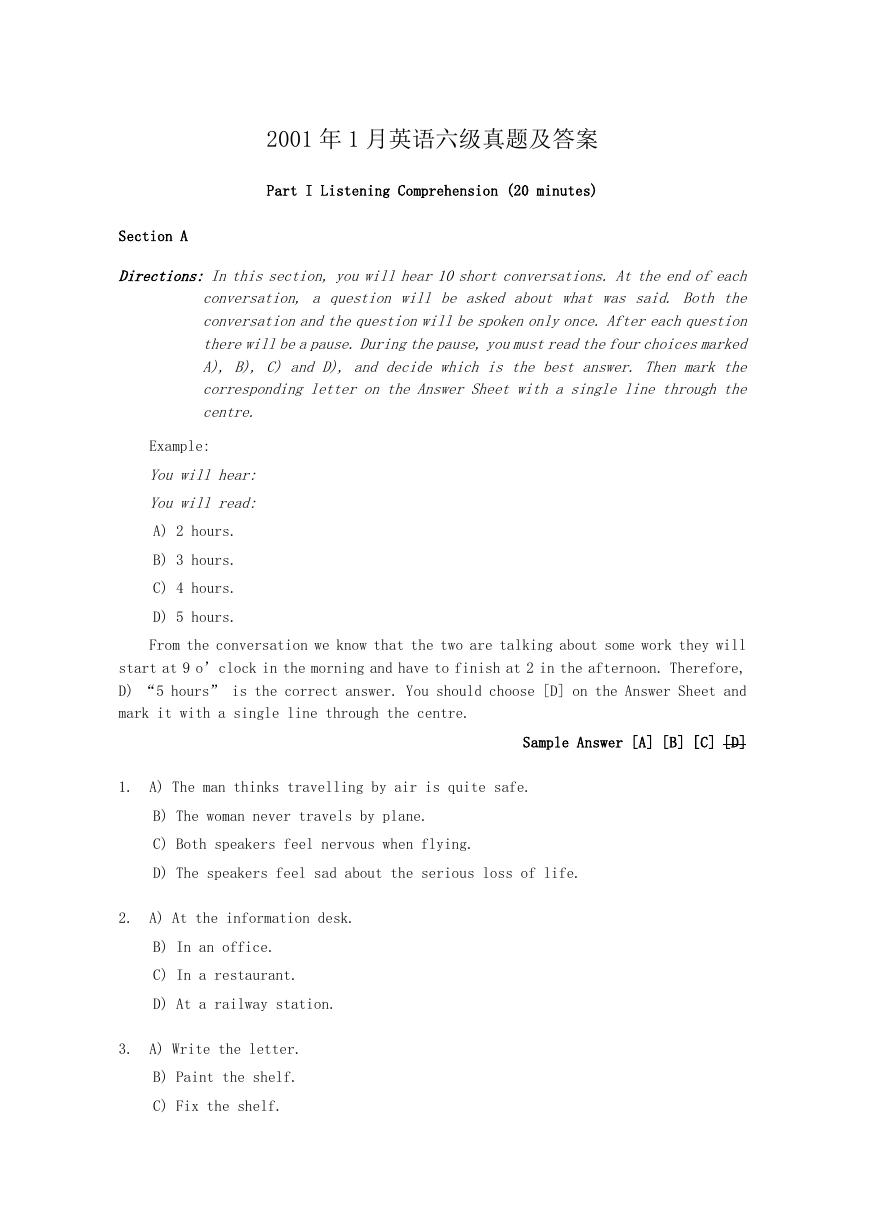
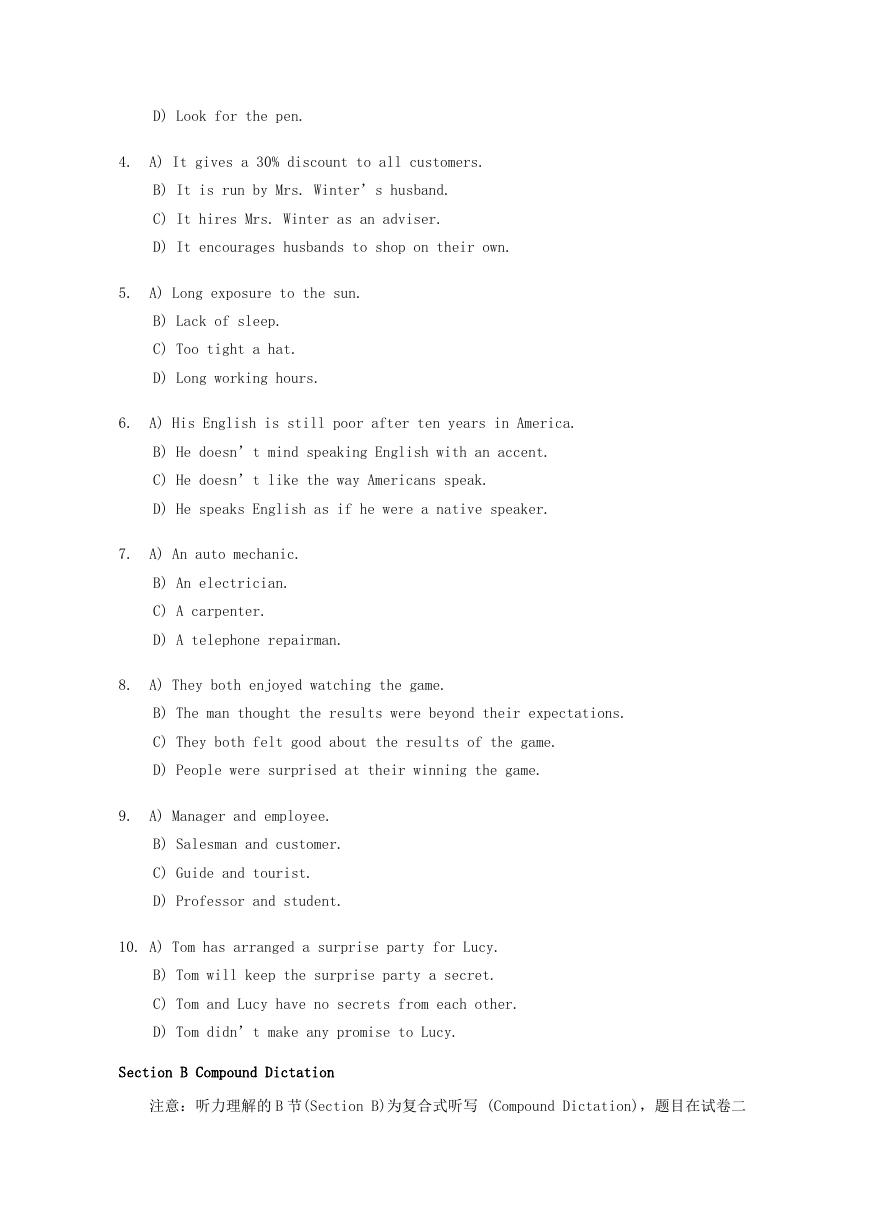
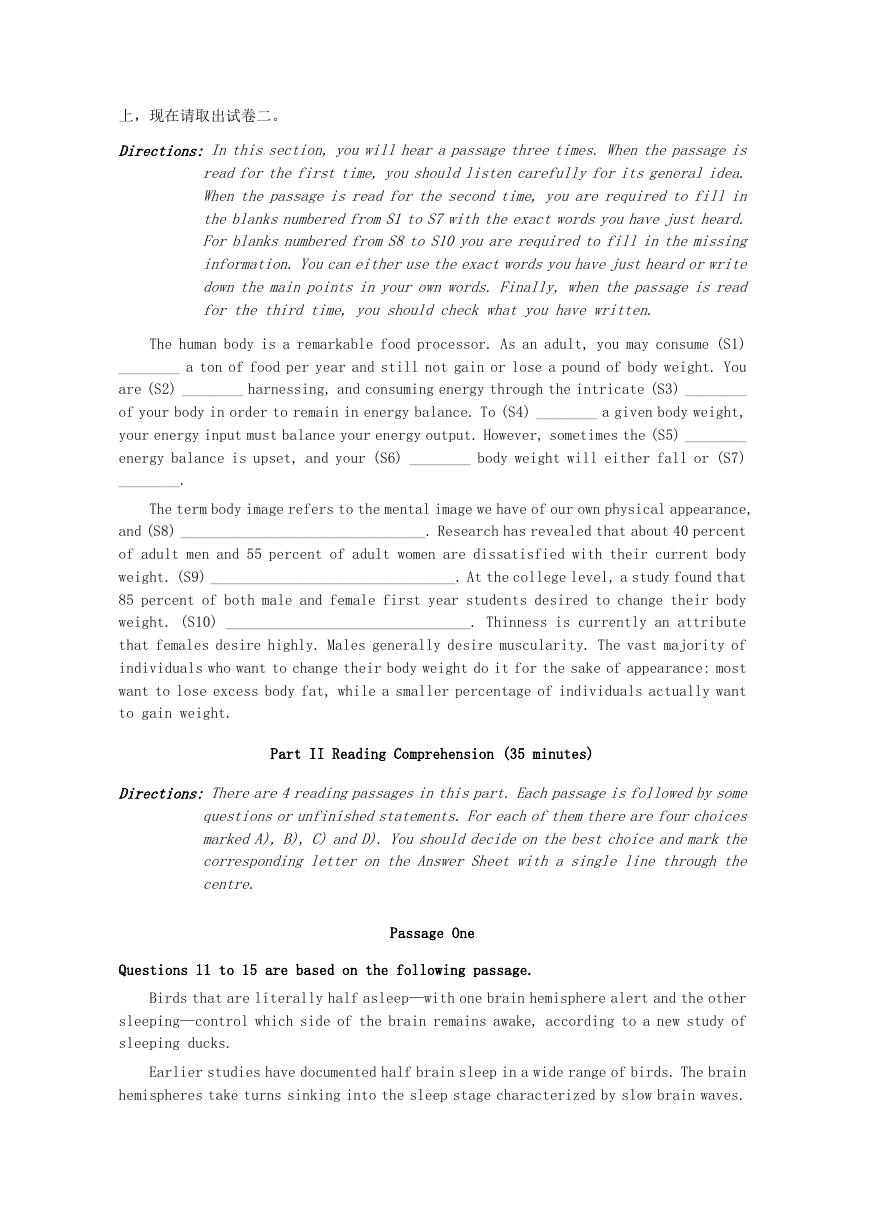
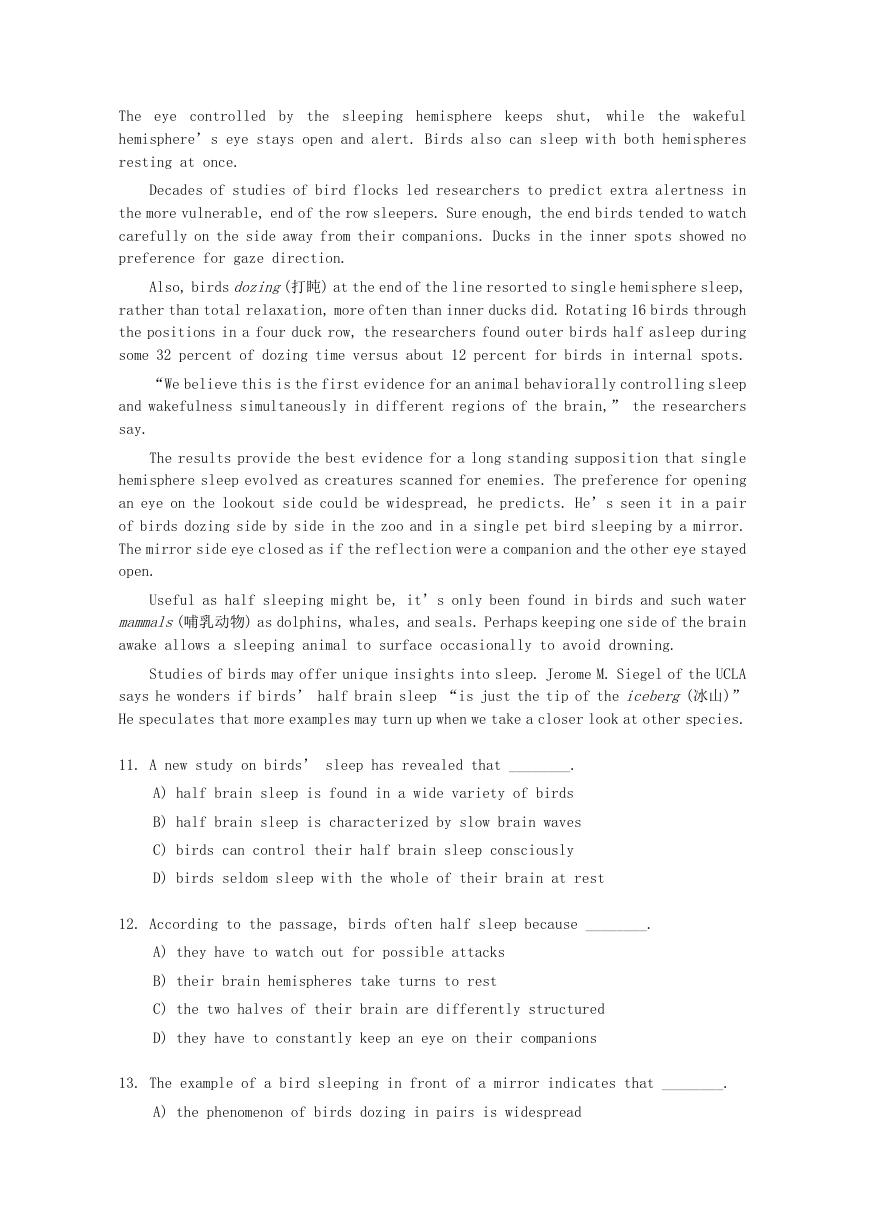

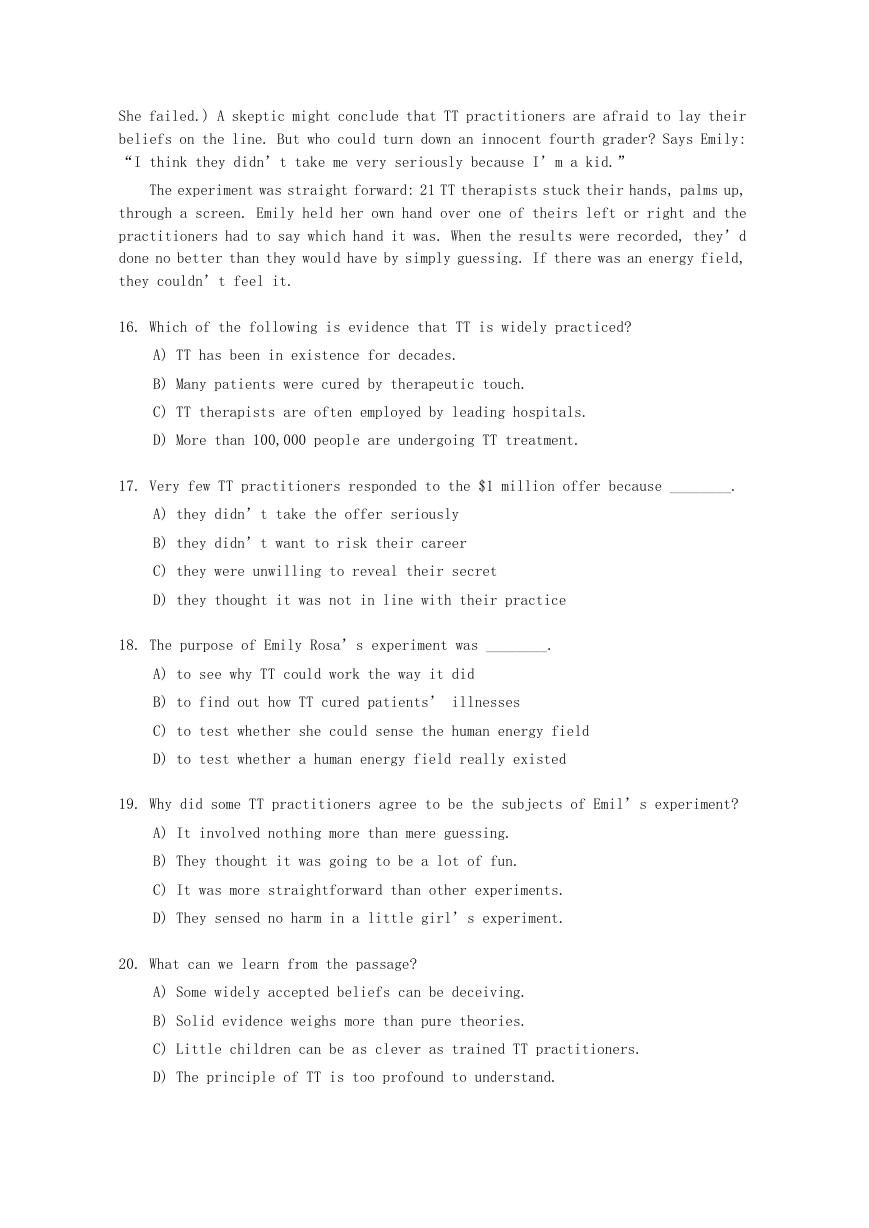
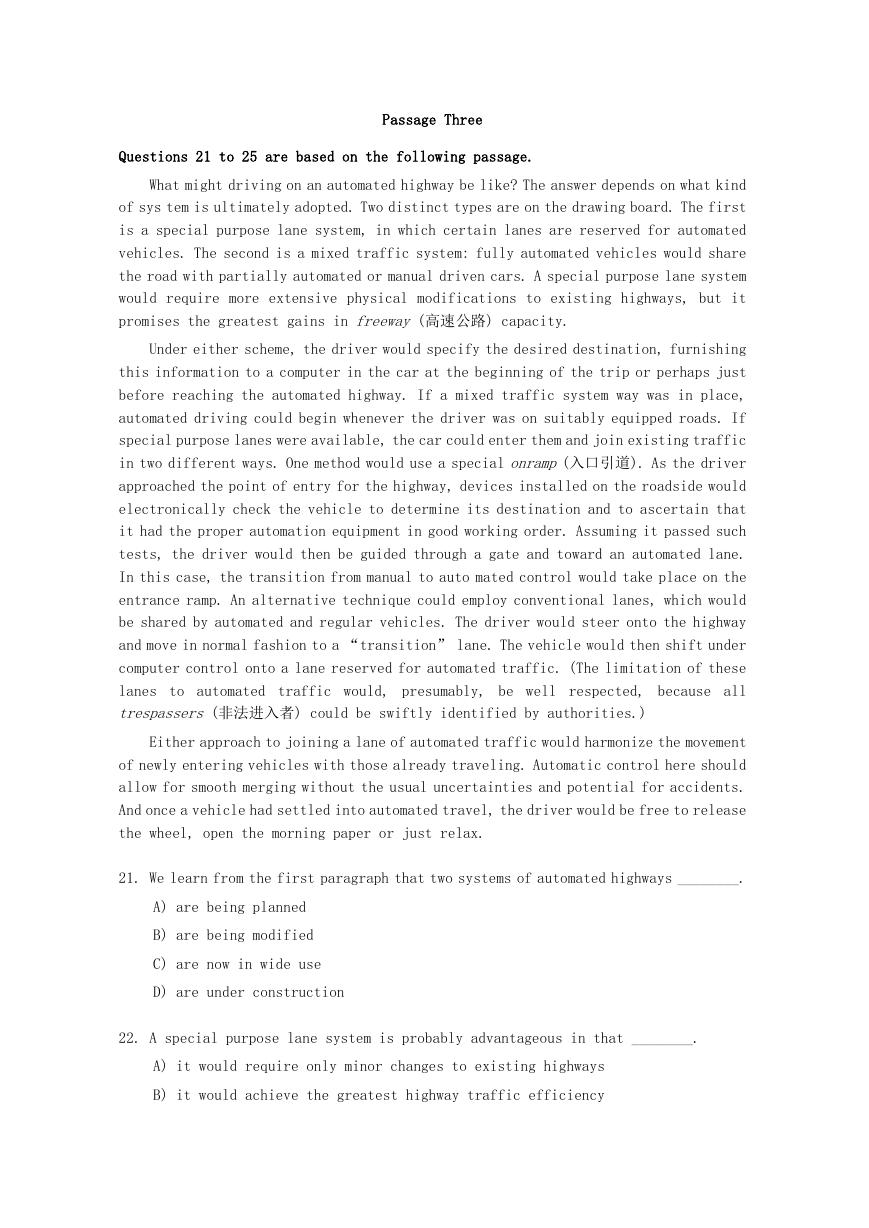









 2023年江西萍乡中考道德与法治真题及答案.doc
2023年江西萍乡中考道德与法治真题及答案.doc 2012年重庆南川中考生物真题及答案.doc
2012年重庆南川中考生物真题及答案.doc 2013年江西师范大学地理学综合及文艺理论基础考研真题.doc
2013年江西师范大学地理学综合及文艺理论基础考研真题.doc 2020年四川甘孜小升初语文真题及答案I卷.doc
2020年四川甘孜小升初语文真题及答案I卷.doc 2020年注册岩土工程师专业基础考试真题及答案.doc
2020年注册岩土工程师专业基础考试真题及答案.doc 2023-2024学年福建省厦门市九年级上学期数学月考试题及答案.doc
2023-2024学年福建省厦门市九年级上学期数学月考试题及答案.doc 2021-2022学年辽宁省沈阳市大东区九年级上学期语文期末试题及答案.doc
2021-2022学年辽宁省沈阳市大东区九年级上学期语文期末试题及答案.doc 2022-2023学年北京东城区初三第一学期物理期末试卷及答案.doc
2022-2023学年北京东城区初三第一学期物理期末试卷及答案.doc 2018上半年江西教师资格初中地理学科知识与教学能力真题及答案.doc
2018上半年江西教师资格初中地理学科知识与教学能力真题及答案.doc 2012年河北国家公务员申论考试真题及答案-省级.doc
2012年河北国家公务员申论考试真题及答案-省级.doc 2020-2021学年江苏省扬州市江都区邵樊片九年级上学期数学第一次质量检测试题及答案.doc
2020-2021学年江苏省扬州市江都区邵樊片九年级上学期数学第一次质量检测试题及答案.doc 2022下半年黑龙江教师资格证中学综合素质真题及答案.doc
2022下半年黑龙江教师资格证中学综合素质真题及答案.doc